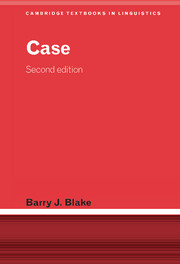Book contents
- Frontmatter
- Contents
- List of figures
- List of tables
- Preface to the Second Edition
- Preface to the First Edition
- List of abbreviations
- 1 Overview
- 2 Problems in describing case systems
- 3 Modern approaches to case
- 4 Distribution of case marking
- 5 Survey of case marking
- 6 Life cycle of case systems
- Notes
- Guide to terminology
- Guide to further reading
- References
- Author index
- Language index
- Subject index
4 - Distribution of case marking
Published online by Cambridge University Press: 05 June 2012
- Frontmatter
- Contents
- List of figures
- List of tables
- Preface to the Second Edition
- Preface to the First Edition
- List of abbreviations
- 1 Overview
- 2 Problems in describing case systems
- 3 Modern approaches to case
- 4 Distribution of case marking
- 5 Survey of case marking
- 6 Life cycle of case systems
- Notes
- Guide to terminology
- Guide to further reading
- References
- Author index
- Language index
- Subject index
Summary
Introduction
This chapter describes the distribution of case marking within the sentence. The order of presentation is clause level (4.2), phrase level (4.3) and then word level (4.4). The distribution of case marking in subordinate clauses is treated in the final section 4.5.
Within the clause
In the clause case marks the relationship of various complements and adjuncts to the predicate. These complements and adjuncts are usually realised by noun phrases or adverb phrases, and the predicate is usually a verb. This function of case is the basis for the central definition of case given at the beginning of chapter 1, and numerous examples of this function are to be found throughout the text and do not therefore need further illustration here. However, as noted in section 1.2.1, case marking may also be found on dependents within a noun phrase or on words, mostly nouns and adjectives, in predicative function.
In a construction such as Virgil's vēnit summa diēs ‘The last day came’ the nominative case on diēs ‘day’ indicates that it bears the subject relation to the verb vēnit and this usage fits our central definition. However, the nominative on the adjective summa ‘highest’ does not indicate that summa is subject, but that it is a modifier of the subject. This usage is somewhat marginal to our central definition, since the nominative here is merely specifying that summa is a dependent of diēs without specifying a type of relation between summa and diēs (see also section 4.3).
- Type
- Chapter
- Information
- Case , pp. 93 - 117Publisher: Cambridge University PressPrint publication year: 2001
- 1
- Cited by

